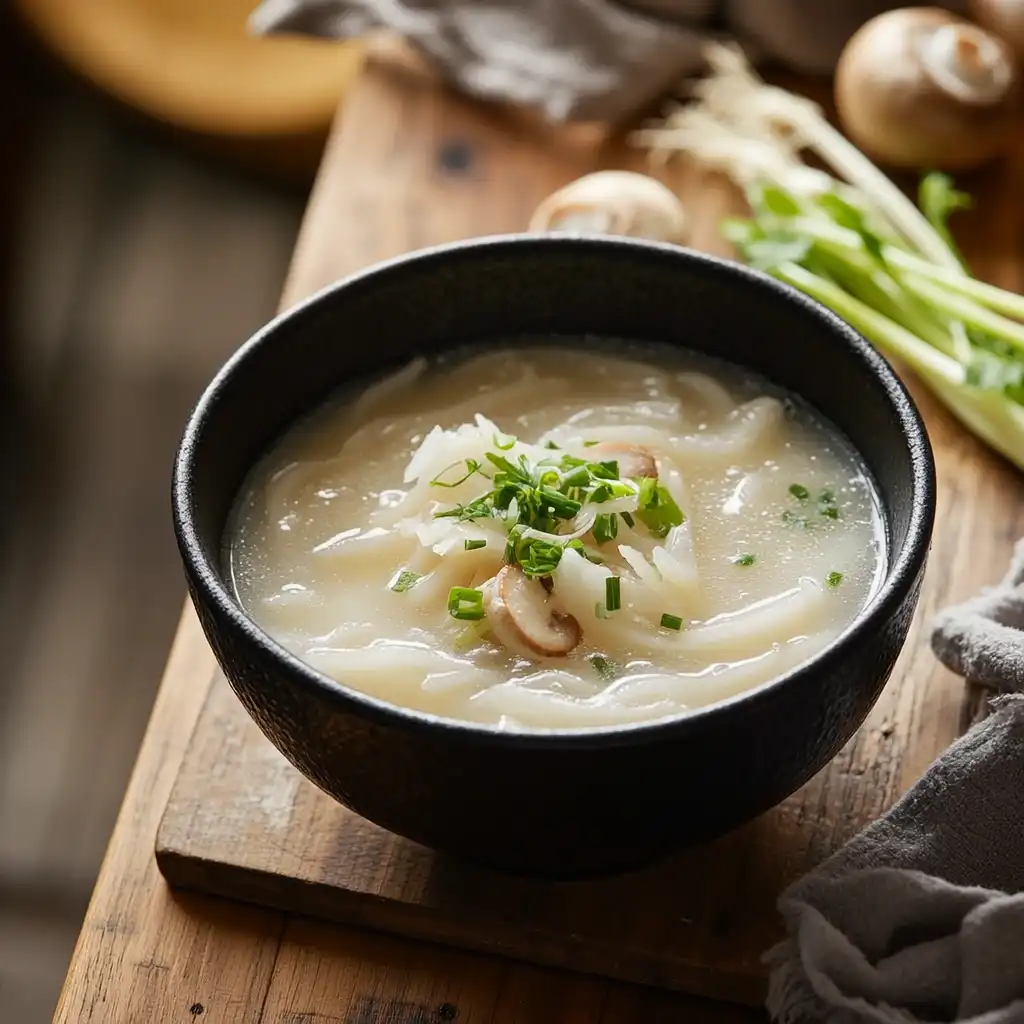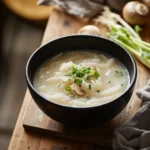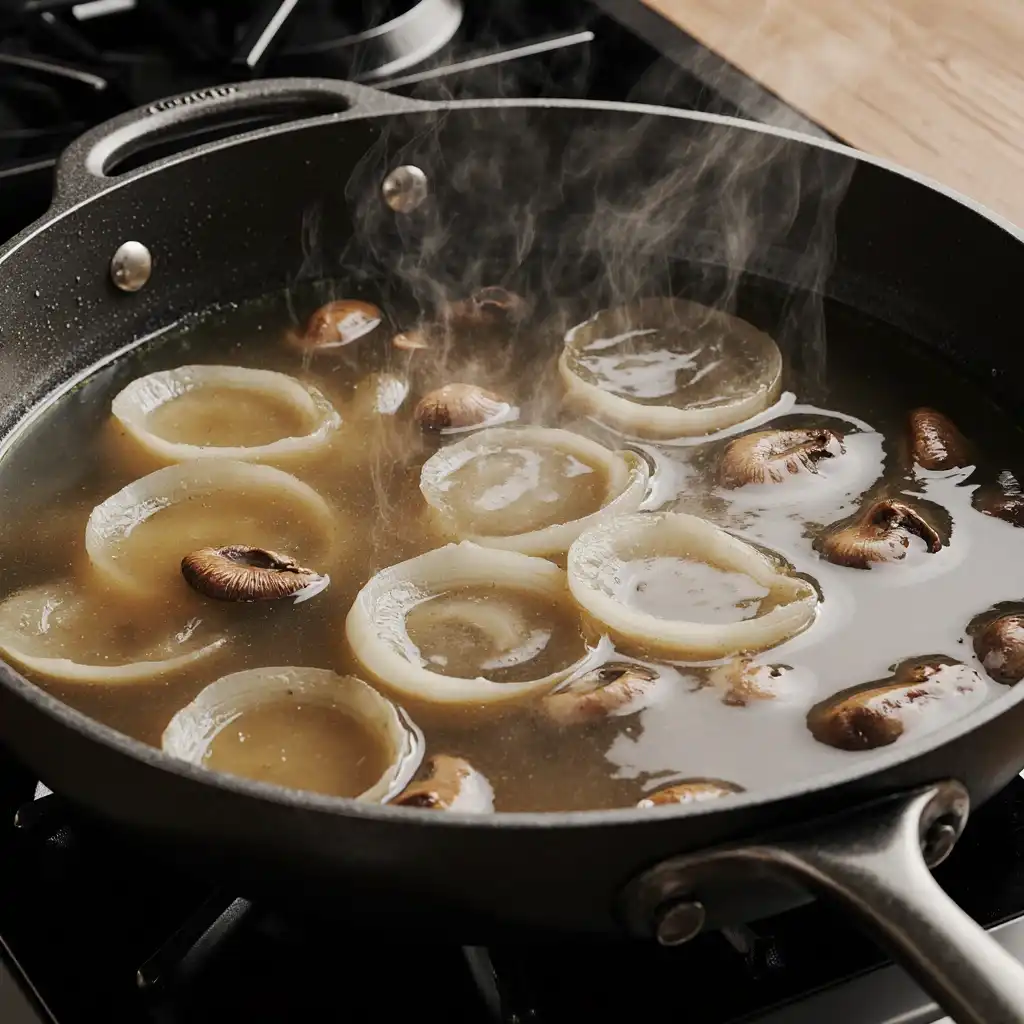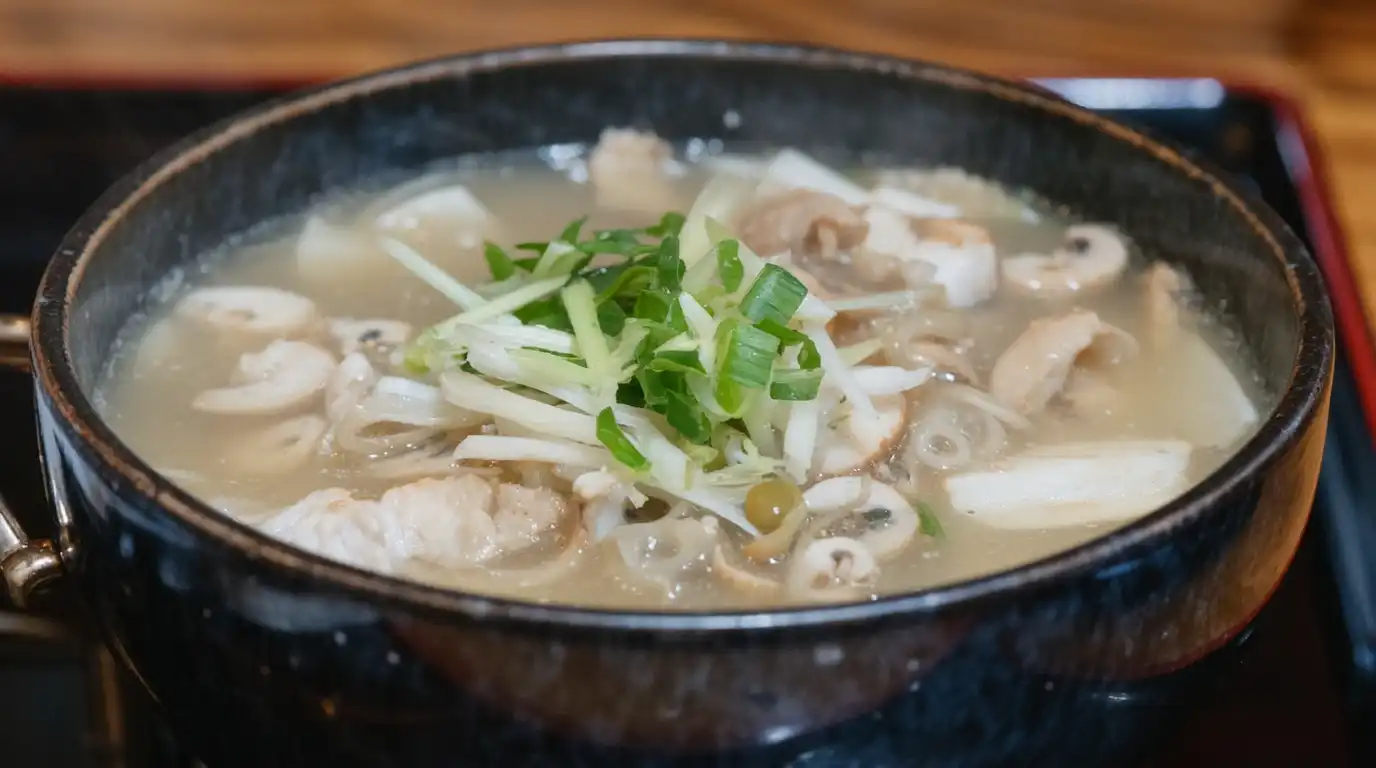Japanese clear onion soup is one of those dishes that manages to be light, healthy, and incredibly comforting all at once. Known in Japan as suimono or simply clear soup, this warm and savory starter has made its way from traditional Japanese kitchens to hibachi-style steakhouses across the world. With its crystal-clear broth, gentle onion sweetness, and subtle umami from kombu or mushrooms, it’s a true representation of how Japanese cuisine finds elegance in simplicity. This guide will take you through its origins, essential ingredients, step-by-step preparation, nutrition details, and expert tips for serving it just like your favorite Japanese restaurant. If you enjoy authentic Asian starters, check out our Japanese clear soup recipe for another delightful variation.
Table of Contents
Table of Contents
Introduction to Japanese Clear Onion Soup
Origins of Japanese Clear Onion Soup
Japanese clear onion soup has its roots in suimono, a light broth often served as part of a traditional Japanese meal known as kaiseki. While the exact recipe varies across regions, the essence remains the same — a transparent, delicate broth designed to cleanse the palate and prepare the appetite for the next course. Its use of onion as a star ingredient is more common in the Westernized hibachi version found in Japanese-American steakhouses, where onions, carrots, and mushrooms are simmered in a clear, flavorful stock.
The broth is usually prepared using a base of dashi — a stock made from kombu (dried kelp) and katsuobushi (bonito flakes). However, in onion-focused recipes, a combination of vegetable stock and subtle seasonings creates a mellow sweetness and an inviting aroma. This blending of traditional Japanese methods with Western preferences is what has made Japanese clear onion soup a restaurant favorite worldwide.
Why It’s Popular in Japanese Cuisine
Part of the soup’s charm lies in its balance. It’s light enough to serve before a heavy meal yet flavorful enough to be enjoyed on its own. The clear presentation is also symbolic in Japanese culinary culture — it reflects precision and purity in cooking. In hibachi restaurants, the soup is often served with a small garnish of thinly sliced mushrooms, scallions, or crispy fried onions to add texture without clouding the broth.
Japanese clear onion soup is also versatile. It can be adapted to vegetarian or vegan diets by replacing bonito flakes with shiitake mushrooms for depth. It can also be made in larger batches and stored for quick, nourishing meals during the week — perfect for those who want a warm, low-calorie dish that doesn’t compromise on flavor.

Ingredients for Japanese Clear Onion Soup Recipe
Essential Ingredients for Authentic Flavor
The beauty of a Japanese clear onion soup recipe lies in its simplicity. You don’t need a pantry full of exotic ingredients to achieve the light, clean taste that makes this soup a favorite in both traditional and hibachi-style dining. Here are the essential components you’ll need for an authentic base:
- Onions – Yellow onions are most common for their natural sweetness after simmering.
- Carrots – Add gentle sweetness and a hint of color.
- Celery – Brings balance with a mild, herbal note.
- Garlic – Used sparingly to enhance the savory depth without overpowering.
- Mushrooms – White button or shiitake mushrooms add umami richness.
- Vegetable or Chicken Stock – The foundation of your broth; use low-sodium for better control over seasoning.
- Soy Sauce – Adds saltiness and umami while deepening color slightly.
- Salt & Pepper – Adjust to taste for seasoning balance.
Pro tip: For the most authentic Japanese experience, consider making a kombu dashi base by simmering dried kelp and optional dried shiitake mushrooms before adding vegetables.
Optional Ingredients for Personal Taste
While the essentials will give you a classic version, Japanese clear onion soup can be customized depending on your preferences or dietary needs. These optional additions can elevate the flavor or give it a restaurant-style touch:
- Ginger slices – Fresh ginger adds a warming spice note.
- Green onions/scallions – Sliced thin and added at the end for a burst of freshness.
- Fried onions – A crunchy topping often served at hibachi restaurants.
- Seaweed (wakame) – Offers a mild oceanic flavor and extra minerals.
- Miso paste – For a slightly richer, more savory twist (though it will cloud the broth).
- Daikon radish slices – Adds sweetness and a crisp texture when lightly simmered.

Japanese Clear Onion Soup Recipe – Authentic & Flavorful Japanese Classic
- Total Time: 50 minutes
- Yield: 4 servings 1x
Description
A light, flavorful Japanese clear onion soup inspired by hibachi restaurants, perfect as a healthy starter.
Ingredients
- 1 medium yellow onion, sliced thin
- 1 medium carrot, sliced thin
- 2 celery stalks, sliced thin
- 2 cups mushrooms (white button or shiitake), sliced
- 4 cups vegetable or chicken stock (low sodium)
- 1 tablespoon soy sauce
- 1 clove garlic, smashed
- Salt & pepper to taste
- Green onions or fried onions for garnish
Instructions
- Prepare the vegetables: Slice onions, carrots, celery, and mushrooms evenly for uniform cooking.
- Combine ingredients: Add vegetables, stock, soy sauce, and garlic to a large pot.
- Simmer gently: Bring to a light simmer over medium heat, then reduce to low. Avoid boiling to maintain broth clarity.
- Cook for depth: Simmer for 30–40 minutes, skimming any foam from the surface.
- Strain the broth: Use a fine-mesh sieve for a clear soup.
- Season and serve: Adjust with salt and pepper, then garnish with green onions or crispy fried onions.
Notes
For a vegetarian/vegan version, use vegetable stock and skip any bonito-based dashi. Add a few slices of fresh ginger for a warming flavor. Strain twice for an ultra-clear broth, especially if serving for guests. Can be refrigerated for up to 4 days or frozen for up to 3 months.
- Prep Time: 10 minutes
- Cook Time: 40 minutes
- Category: Soup / Appetizer
- Method: Stovetop
- Cuisine: Japanese
Nutrition
- Serving Size: 1 serving
- Calories: 35
- Sugar: 3g
- Sodium: 420mg
- Fat: 0.5g
- Saturated Fat: 0g
- Trans Fat: 0g
- Carbohydrates: 7g
- Fiber: 1g
- Protein: 2g
- Cholesterol: 0mg
Keywords: Japanese clear soup, onion soup, hibachi starter, healthy appetizer
If you’re new to Japanese cooking, discover great ideas like our Japanese pink salt diet recipe, which also blends authentic flavors with a modern healthy twist.
Step-by-Step Japanese Clear Onion Soup Recipe
Preparation Techniques for Best Results
Making a Japanese clear onion soup that’s both flavorful and crystal-clear requires a balance of technique and patience. The secret is in slow simmering — never boiling — to prevent the broth from becoming cloudy. Here’s how to prepare your vegetables and stock for the best outcome:
- Select fresh vegetables – Use firm onions, crisp celery, and fresh carrots for the cleanest flavor.
- Cut evenly – Uniform slices help vegetables cook evenly and release flavor at the same rate.
- Skim often – Any foam that rises to the top during simmering should be removed to maintain clarity.
- Season gradually – Add salt and soy sauce in small amounts, tasting as you go.
This careful preparation ensures a light broth with deep flavor that still lets each ingredient shine.
Cooking Process for Perfect Clarity
Below is a simple yet authentic method to make Japanese clear onion soup at home.
Ingredients (Serves 4):
- 1 medium yellow onion, sliced thin
- 1 medium carrot, sliced thin
- 2 celery stalks, sliced thin
- 2 cups mushrooms (white button or shiitake), sliced
- 4 cups vegetable or chicken stock (low sodium)
- 1 tablespoon soy sauce
- 1 clove garlic, smashed
- Salt & pepper to taste
- Green onions or fried onions for garnish
Instructions:
- In a large pot, combine onion, carrot, celery, garlic, and mushrooms.
- Add stock and soy sauce. Bring to a gentle simmer over medium heat.
- Reduce heat to low and simmer for 30–40 minutes, skimming foam occasionally.
- Strain the soup through a fine-mesh sieve for a perfectly clear broth.
- Adjust seasoning with salt and pepper.
- Serve hot, garnished with green onions or crispy fried onions.
Quick Reference Table:
| Step | Action | Time | Key Tip |
|---|---|---|---|
| 1 | Slice vegetables evenly | 5 minutes | Uniform slices = even cooking |
| 2 | Simmer ingredients in stock | 30-40 min | Avoid boiling |
| 3 | Strain and season | 5 minutes | Taste before final seasoning |

If you love classic soups, don’t miss our bariatric pumpkin seed recipe — another healthy, nourishing starter option.
Nutrition Facts & Health Benefits
Is Japanese Clear Onion Soup Healthy?
Absolutely — Japanese clear onion soup is naturally low in calories and fat, making it an excellent choice for those who want a light starter or a comforting low-calorie meal. Its base of vegetables provides essential vitamins and minerals without heavy oils or cream. Since it’s broth-based, it’s also hydrating and easy on the stomach, which is why it’s often served at the start of large meals in Japanese cuisine.
For a vegetarian or vegan version, simply use vegetable stock and replace bonito-based dashi with kombu and shiitake mushrooms. This keeps the soup plant-based while still offering plenty of umami.
Nutritional Profile per Serving
Here’s an approximate nutritional breakdown for a single serving (1 cup) of Japanese clear onion soup:
| Nutrient | Amount per Serving | % Daily Value* |
|---|---|---|
| Calories | 35 | 2% |
| Total Fat | 0.5g | 1% |
| Saturated Fat | 0g | 0% |
| Cholesterol | 0mg | 0% |
| Sodium | 420mg | 18% |
| Total Carbohydrates | 7g | 3% |
| Dietary Fiber | 1g | 4% |
| Sugars | 3g | – |
| Protein | 2g | 4% |
| Vitamin A | 20% | – |
| Vitamin C | 8% | – |
| Calcium | 2% | – |
| Iron | 2% | – |
*Percent Daily Values are based on a 2,000-calorie diet.
Health Highlights:
- Low-calorie starter – Great for portion control and weight management.
- Hydrating – High water content supports hydration.
- Nutrient-rich – Provides vitamins A and C for immune health.
- Digestive-friendly – Gentle on the stomach, ideal for all ages.
For more nutrient-packed recipes, check out our bariatric seed tea recipe, which blends flavor with digestive health benefits.
Flavor Profile & Serving Suggestions
How the Soup’s Light Flavor Enhances Meals
Japanese clear onion soup is defined by its gentle sweetness from onions, balanced by earthy mushrooms and a clean, savory stock. It’s not meant to overwhelm — instead, it refreshes the palate and sets the tone for the meal ahead. The absence of heavy fats or creams means the broth stays crisp and refreshing, while the umami elements from soy sauce or dashi give it depth.
This subtlety is one of the reasons it pairs so well with both delicate and bold dishes. You can serve it before sushi, grilled meats, or even tempura, and it will enhance rather than compete with the main flavors.
Best Pairings with Japanese Clear Onion Soup
To enjoy the soup at its best, serve it alongside:
- Sushi or sashimi platters – The light broth complements raw fish without overpowering its natural taste.
- Hibachi-grilled steak or chicken – A classic restaurant pairing.
- Tempura vegetables or shrimp – The soup helps cleanse the palate between bites of crispy fried food.
- Steamed rice and pickled vegetables – For a simple, homestyle Japanese meal.
- Gyoza (Japanese dumplings) – The savory broth pairs beautifully with the dumpling’s rich filling.

If you’re experimenting with Japanese sides, don’t miss our Japanese pink salt and ice recipe — a refreshing twist perfect for warm days.
Japanese Clear Onion Soup vs. Miso Soup
Key Differences in Ingredients
While both Japanese clear onion soup and miso soup are iconic starters in Japanese cuisine, their bases and flavors are distinctly different.
- Japanese Clear Onion Soup – Typically made with a light vegetable, chicken, or dashi broth, flavored with onions, mushrooms, carrots, and soy sauce. The emphasis is on transparency and a clean, delicate taste.
- Miso Soup – Uses a dashi base enriched with miso paste, a fermented soybean seasoning that gives the soup a cloudy appearance and a robust, savory flavor. Often includes tofu cubes, wakame seaweed, and green onions.
Because miso paste is rich in probiotics, miso soup offers additional gut-health benefits, while Japanese clear onion soup focuses more on lightness and palate-cleansing qualities.
Texture and Flavor Variations
- Texture: Clear onion soup is completely transparent, while miso soup is cloudy and thicker due to dissolved miso paste.
- Flavor: Clear onion soup is mild, with gentle onion sweetness and subtle umami, whereas miso soup has a salty, deep umami punch with earthy undertones from the fermented soybeans.
- Mouthfeel: Clear onion soup feels light and refreshing, while miso soup is heartier and more filling.
Comparison Table:
| Feature | Japanese Clear Onion Soup | Miso Soup |
|---|---|---|
| Base | Vegetable/chicken stock or dashi | Dashi + miso paste |
| Appearance | Clear, transparent | Cloudy |
| Flavor Profile | Mild, sweet-onion umami | Salty, deep umami, earthy |
| Common Add-ins | Mushrooms, carrots, green onions | Tofu, wakame, green onions |
| Calories | Lower | Slightly higher |
For more Japanese-inspired flavors, looking for inspiration? Try our Japanese mounjaro recipe, which also blends tradition with modern health benefits.
Common Questions About Japanese Clear Onion Soup
What is the White Stuff in Japanese Clear Soup?
If you’ve ever been served Japanese clear onion soup and noticed tiny white specks floating on top, you’re likely looking at tofu bits or egg strands. In some recipes, chefs whisk a small amount of beaten egg into the hot broth, creating delicate white ribbons known as kaitan in Japanese cooking.
In other variations, small cubes of silken tofu are added for texture and extra protein. These additions are optional and can be omitted for a purely vegetable-based broth.
What is the White and Pink Thing in Japanese Soup?
That swirly white-and-pink slice is called narutomaki, a type of Japanese fish cake made from pureed white fish paste (surimi) and colored with a pink spiral design. Narutomaki is more commonly seen in ramen, but occasionally hibachi-style soups include it for color and presentation.
It’s completely edible and has a mild, slightly chewy texture that absorbs the flavor of the broth.
Some home cooks replace narutomaki with kamaboko (a plain fish cake without the swirl) or omit it entirely, especially if preparing a vegetarian version.
Pro Tips for Making Restaurant-Quality Soup
Secrets to Keeping Soup Clear and Flavorful
If you’ve ever wondered how hibachi restaurants serve broth that’s both deeply flavorful and crystal clear, the answer lies in technique:
- Use cold water to start: Adding vegetables to cold water and slowly bringing them to a simmer extracts flavor gradually without clouding the broth.
- Never boil: Keep the heat low to avoid breaking down vegetables too quickly, which can cause murkiness.
- Skim often: Remove foam and floating bits with a ladle to maintain a clean appearance.
- Strain twice: Use a fine-mesh sieve, and for extra clarity, strain again through cheesecloth.
- Season at the end: Adding soy sauce and salt toward the end keeps the flavors bright and prevents over-seasoning.
How to Store and Reheat Without Losing Flavor
One of the best things about Japanese clear onion soup is that it stores beautifully if handled correctly:
- Refrigeration: Cool completely before transferring to an airtight container. Store for up to 4 days.
- Freezing: Strain solids before freezing to keep the broth clear. Freeze in portion-sized containers for up to 3 months.
- Reheating: Always reheat slowly over low heat. Avoid boiling, as it can dull flavors and cloud the broth.
- Reviving flavor: Add a splash of fresh soy sauce or a pinch of salt after reheating to refresh the taste.
If you’re exploring ways to make traditional soups even healthier, learn more about our natural ozempic tea recipe, which also focuses on gentle, flavorful infusions.
FAQs
What is Japanese clear soup made of?
Japanese clear soup, also known as suimono or hibachi clear onion soup, is typically made from a light broth base (vegetable, chicken, or dashi) simmered with onions, mushrooms, carrots, and celery. It’s seasoned with soy sauce, salt, and pepper, and sometimes garnished with scallions or fried onions.
Is Japanese clear onion soup healthy?
Yes. It’s naturally low in calories and fat while providing vitamins and minerals from vegetables. When made with low-sodium broth and minimal soy sauce, it’s an excellent light starter for any diet.
What is in Japanese onion soup?
Japanese onion soup contains onions as the star ingredient, along with carrots, celery, mushrooms, soy sauce, and a light broth. Garnishes like green onions, fried onions, or tofu may also be included.
What is the white stuff in Japanese clear soup?
The white bits are often tofu cubes or delicate egg ribbons added for texture. They’re optional and can be left out if you prefer a purely clear broth.
What is the difference between Japanese clear soup and miso soup?
Japanese clear soup uses a transparent broth without miso paste, offering a lighter, cleaner flavor. Miso soup contains fermented soybean paste, giving it a cloudy appearance and a more robust, salty taste.
What is the white and pink thing in Japanese soup?
That’s narutomaki, a type of fish cake with a pink swirl. It’s mostly used for visual appeal and has a mild, slightly chewy texture that soaks up broth flavor.
Conclusion
Japanese clear onion soup is a perfect example of how simple ingredients, prepared with care, can deliver remarkable flavor. Its light broth, delicate sweetness from onions, and gentle umami make it both comforting and refreshing. Whether you enjoy it as a warm start to a Japanese feast or as a wholesome homemade meal on its own, this soup brings elegance to everyday cooking. With the right technique, you can recreate that restaurant-quality clarity and taste in your own kitchen.
Follow Kamala Recipes for exclusive recipes that balance hormones, reduce cravings, and support sustainable weight loss—every single day.

